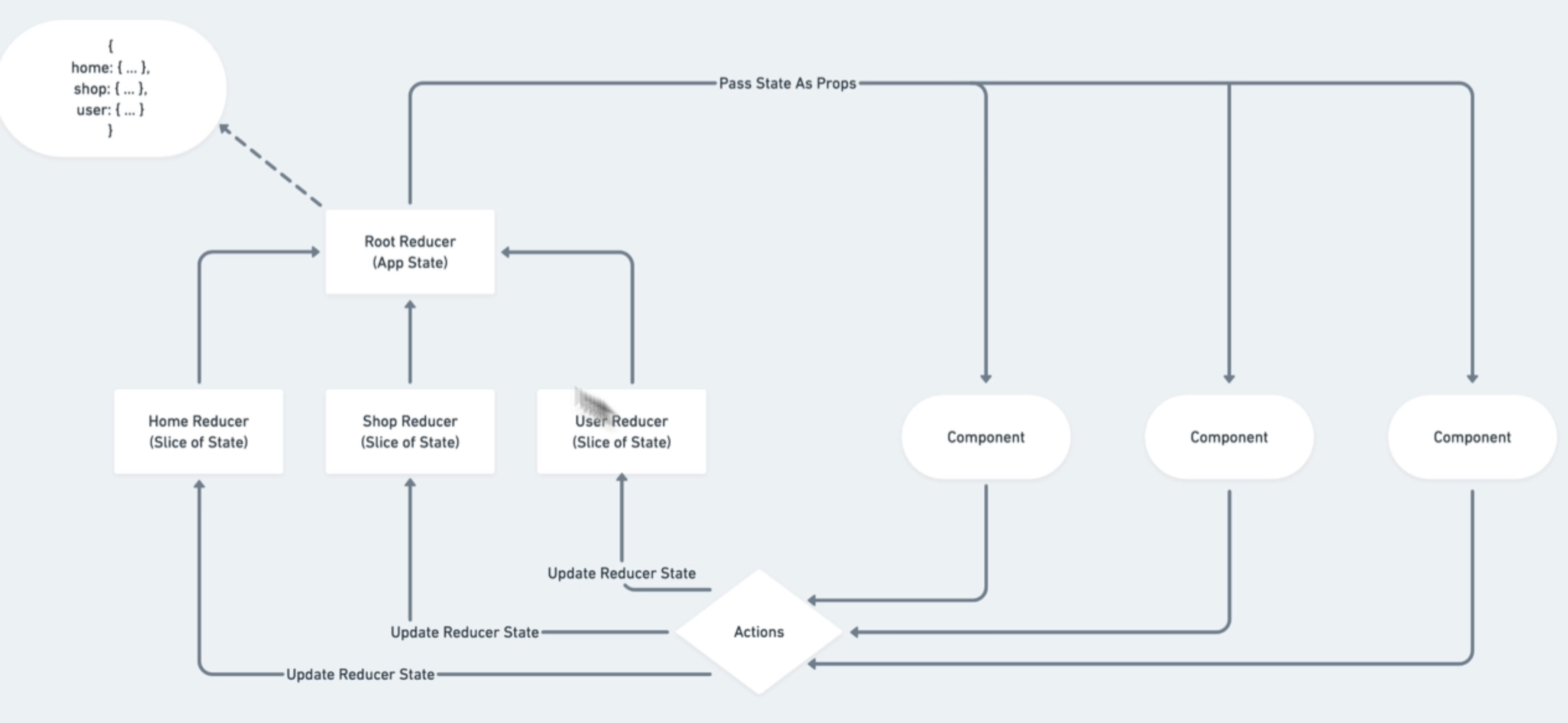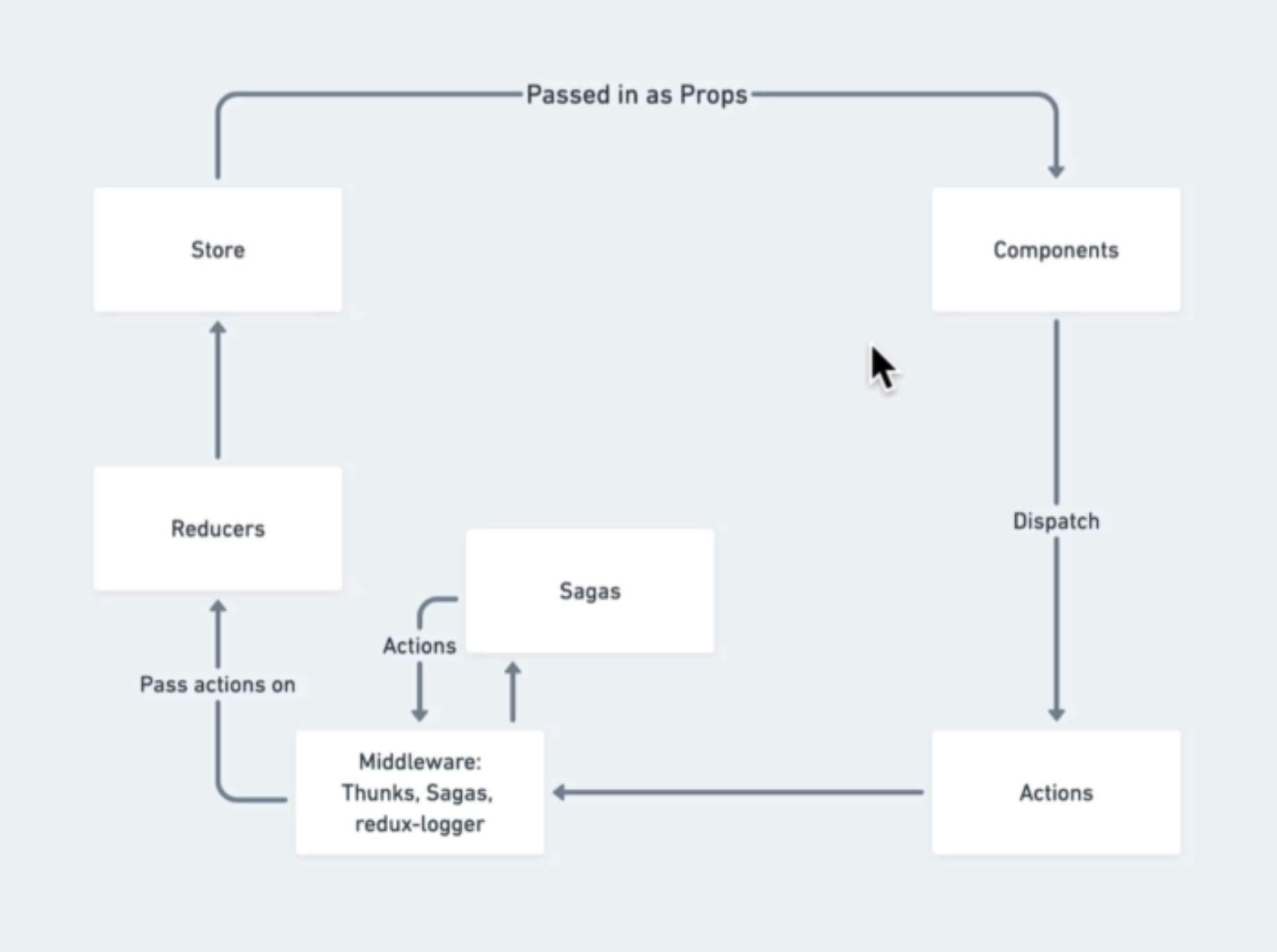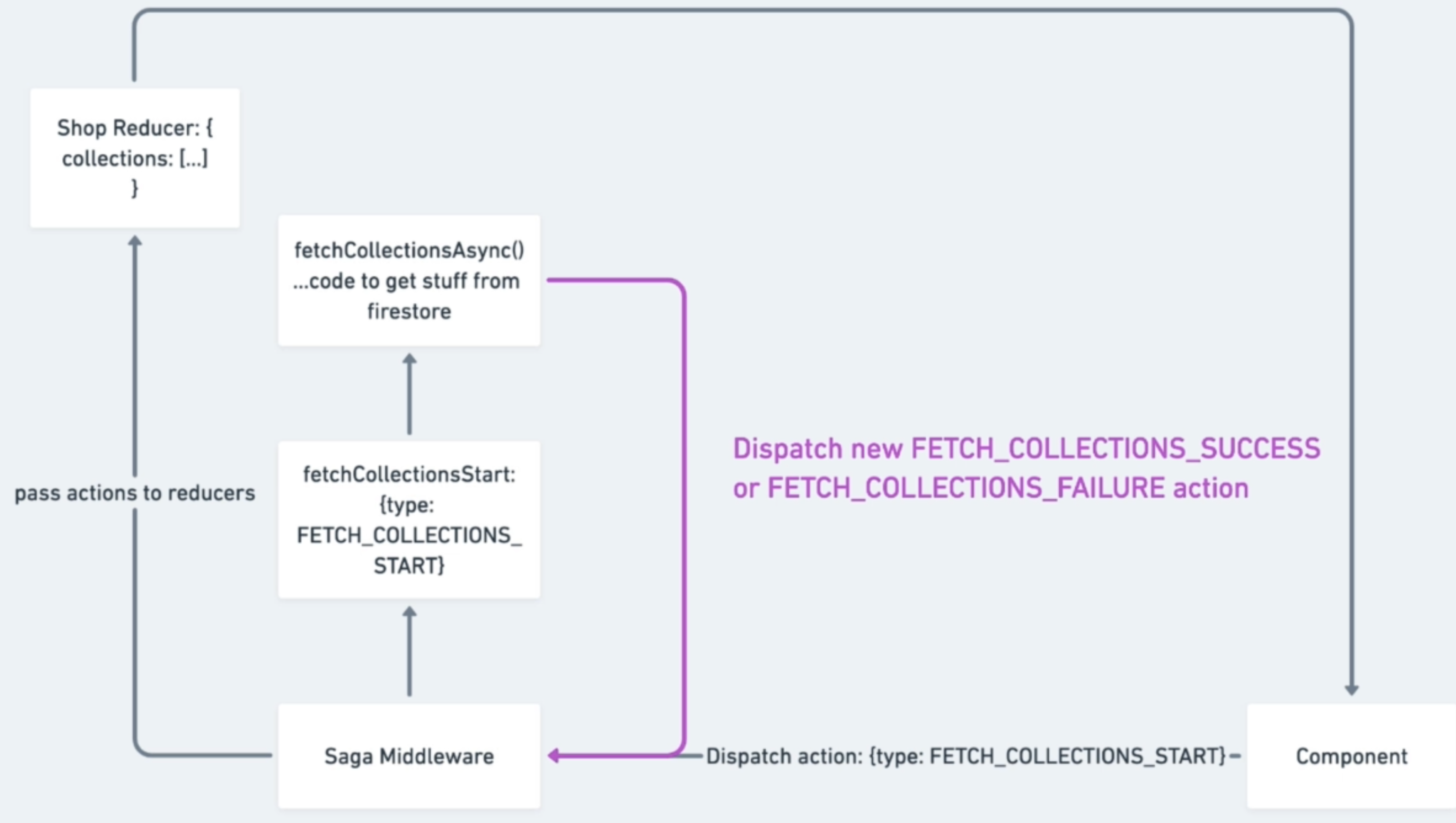This project was bootstrapped with Create React App.
- Each document in carts collection is an object containg userId whose cartItems it is and CartItems array.
- Whenever user sign-in is successful, this action is intercepted by cart-saga, which then asynchronously retrieves cartItems array from firestore and if successful cartItems array is updated in redux-store to display in front-end by dispatching an action.
- Whenever user adds/removes/clears/checks-out successfully(which leads to clearing cart), the respective actions which are dispatched are also intercepted by cart-saga which then asynchronously updates the cartItems array for that user in firestore db(These actions are also handled by redux and redux changes cartItems array in redux-store accordingly and updates cart State with reducer. However, it's important to note that when an action is dispatched to the store, the middleware first forwards the action to the reducers and then notifies the Sagas. This means that when you query the Store's State, you get the State after the action has been applied.).
- Added Following rules to our users, collections and carts collection in firestore db to prevent unauthorised access.
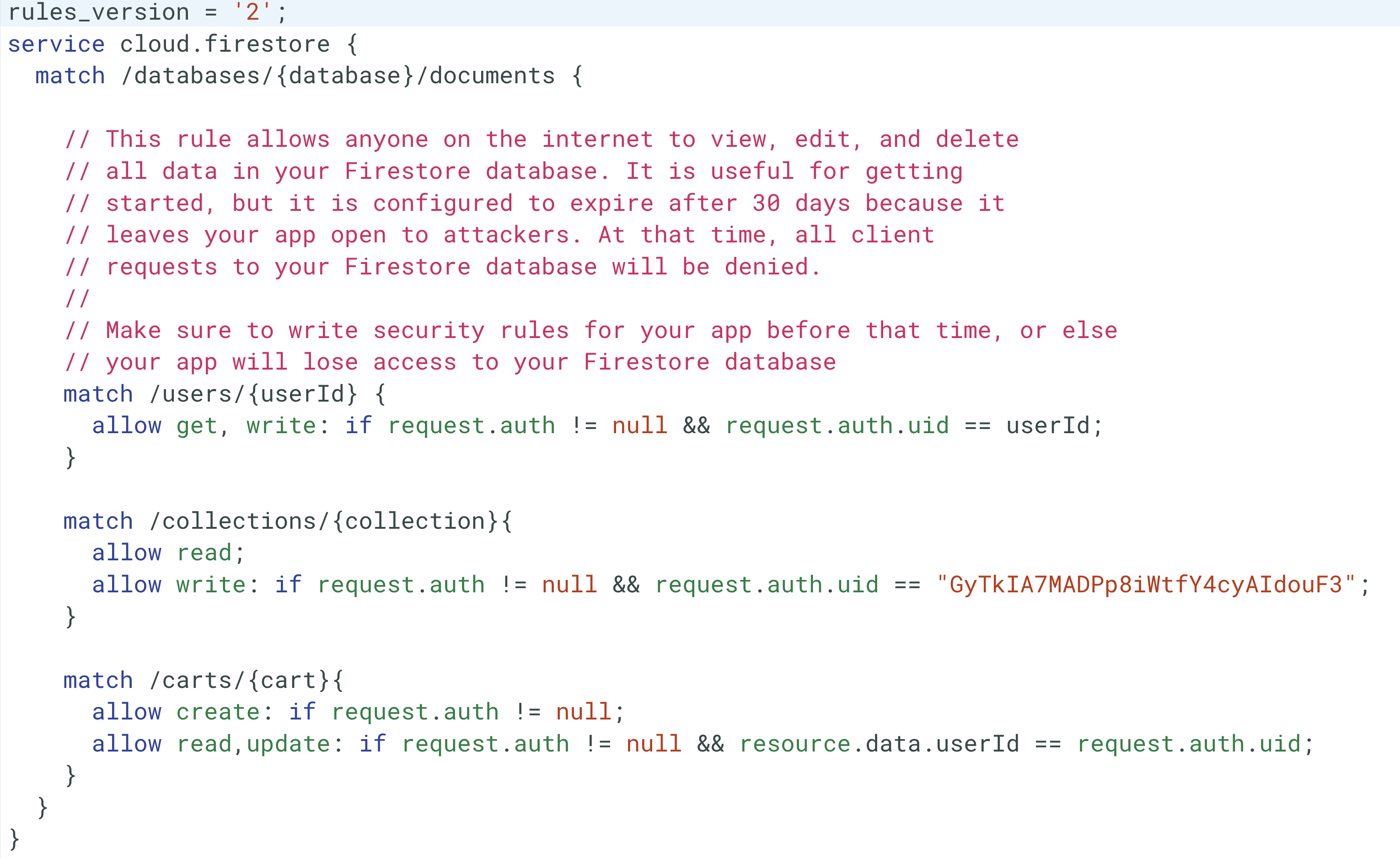
- For users, one can get/write userDoc only if they are authenticated and authenticated user id matches the user id one is trying to get/write.
- For collections, anyone can read as we are allowing even unauthenticated users to view our collections. However, write(create/update/delete) is only allowed if the current user is authenticated and his id matches the admin's.
- For carts, as long as user is authenticated he/she can create a cart document in carts Collection. For read/update, there is additional condition that user's id should match cartDoc's userId.
-
Thunks are actionCreators that returns a function instead of action(i.e normal actionCreators return object)..They also get dispatch as its argument...So whenever an Action-Creator returns a 'function', thunk automatically attaches to it and using dispatch we can dispatch other actions inside this thunk...Thunk is mainly used to perform asynchronous actions
- In our code, since getting shopData from firestore is asynch and to make it reusable for other pages apart from Shop in future, we made fetching shopData a redux action, dispatching which fetches shopData. Since, it is asynch, we used redux-thunk library to create this action which in turn can fire other actions like fetchSuccess,fetchFailure etc.
redux-saga is a library that aims to make application side effects (i.e. asynchronous things like data fetching and impure things like accessing the browser cache) easier to manage, more efficient to execute, easy to test, and better at handling failures. It is better than redux-thunk in handling async actions.It uses an ES6 feature called Generators(generator fn) to make those asynchronous flows easy to read, write and test and syntax is similar to async/await. It can listen to an action being dispatched and also dispatch an action.
Main Advantage over redux-thunk and also of yield over async/await is that with yield an action/fn that has been run can be stopped in-flight i.e from progressing to logic after yield command as saga-middleware is responsible for calling the generator function's next(), however async fnc and redux-thunk once started can't be aborted.
To summarize, Redux-saga has listeners for events using take,takeEvery and takeLatest. When an action is dispatch to store that matches Action pattern in listeners, saga-middleware intercepts that action and then does something with it like fetching data from API etc(generally async things) and even dispatch other actions. Once this is done, it then allows redux flow to resume if no other actions being dispatched matches its listener's action-pattern.
Hooks are a new addition in React 16.8. They let you use state and other React features without writing a class.
- useState()-> mimicks state and setState.. eg: const [ stateName,setStateMethodName ]= useState('Mary') this will make a state with initial value Mary which can be changed as: setStateMethodName('New-Value'). Example Code
- useEffect()-> The Effect Hook lets you perform side effects in function components and can be used as componentDidMount, componentDidUpdate, and componentWillUnmount combined. Example Code
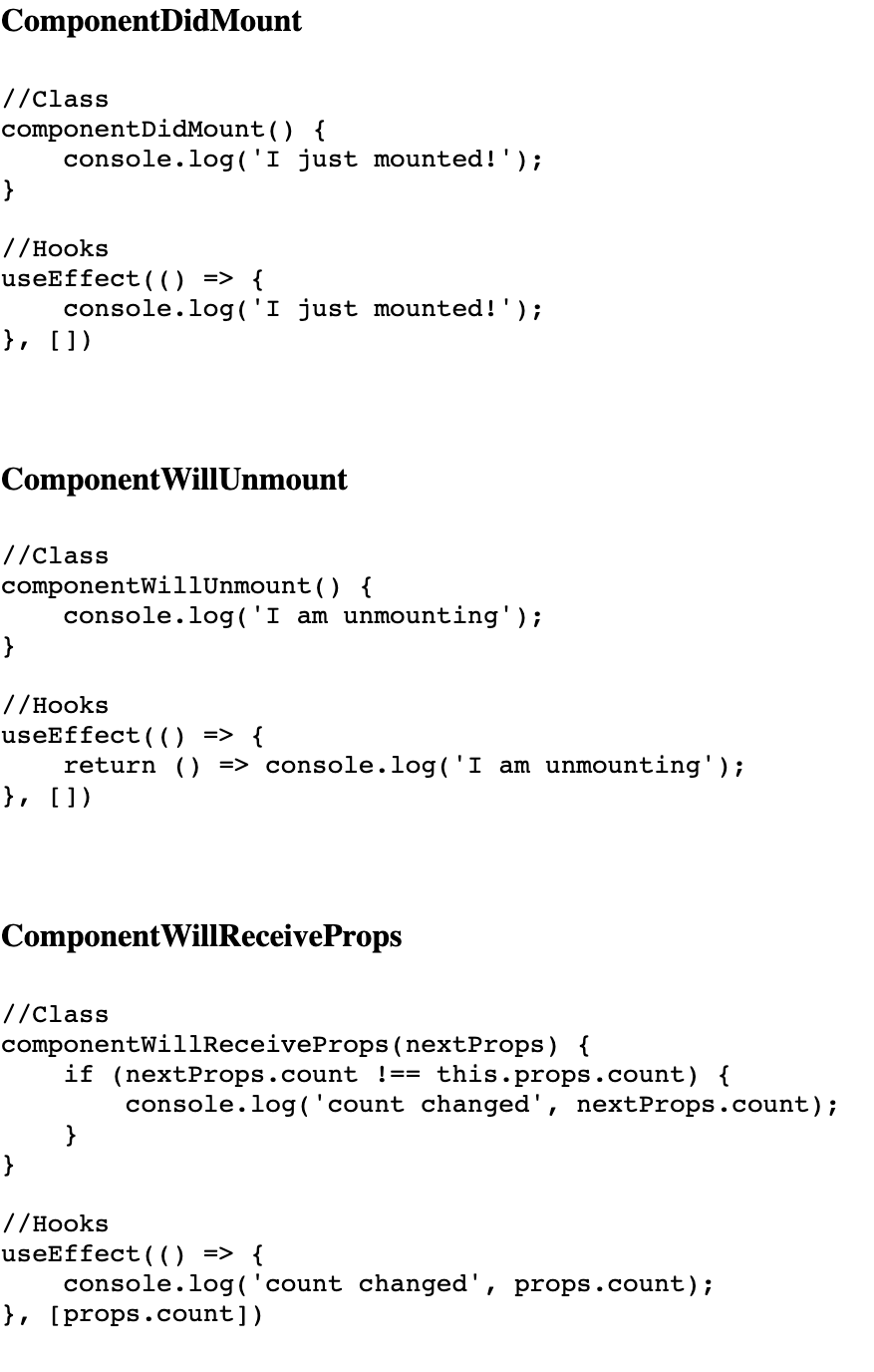
- useContext()-> Not needed for our App now.
- useReducer()-> This react native way of local state management whose scope is a Component it is used in. Its syntax is similar to redux but unlike redux it is not a global store and mostly suited for smaller Apps whose state logic is a bit complicated to use useState() hook so useReducer() replaces useState() hook. Example Code
- customHooks()-> Our custom hooks generally written with purpose for reusing it in multiple components and made using above Hooks like useState, useEffect. Naming convention states fn name to start with 'use'. Example Code
-
Moved responsibility of HOC wrapping of Collection and CollectionsOverview Pages from Shop to above Components itself by making new Container files for the 2 components whose job is to render actual Component or Loading Spinner according to condition by wrapping to WithSpinner HOC. Now Shop's page only role is to route to CollectionPage or CollectionsOverview Page according to route.
- This was done to ensure seperation of concerns as Job of rendering Loading Spinner or data if available for a component should be its own responsibility.
-
- We just added redux-saga into our application! The first thing we did is to convert our fetchCollectionsStartAsync thunk method into a saga instead to fetch our collections. We added a root-saga which takes all sagas(actions/events) we want our sagas-middleware to listen to. For now we only have the shop Sagas to get Collections from firestore as soon as it sees that action FETCH_COLLECTIONS_START has been dispatched(which happens as soon as shop-page mounts).
-
We also added sign-in feature to redux using redux-sagas which listens for start of said action and then fetches required data(which is async).
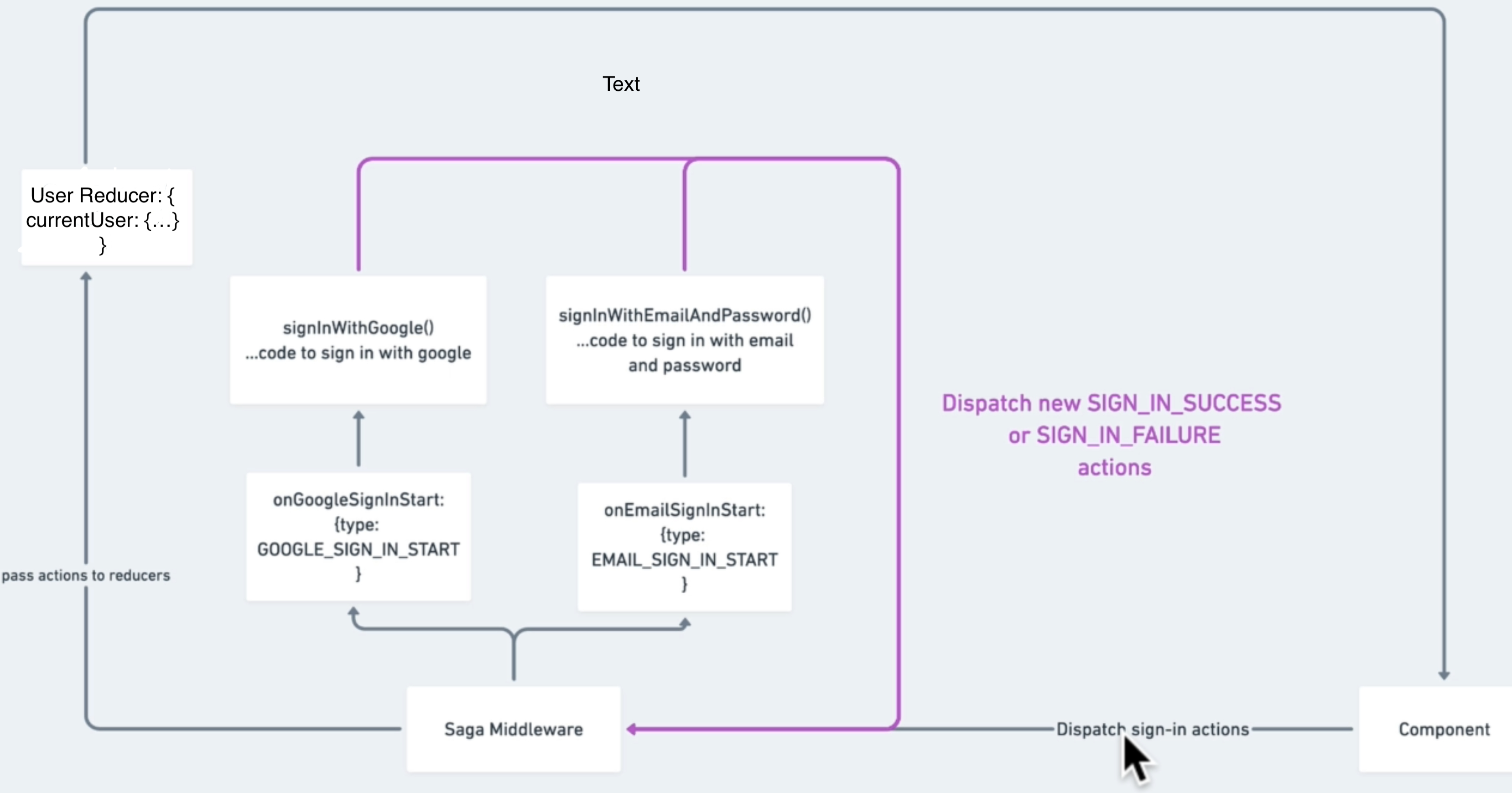
-
Added persistence to sign-in feature.As soon as APP component mounts, an action called CHECK_USER_IN_SESSION is dispatched which is intercepted by redux-saga which then uses firebase utils to check if any user is present in session using auth.onAuthStateChanged and if so currentUser is set by dispatching action SIGN_IN_SUCCESS.
-
We added sign-out feature to redux using sagas similar to above actions i.e clicking SIGN-OUT button dispatches an action 'SIGN_OUT_START' which is intercepted by user-sagas which then performs the async function to sign out user, which if successful dispatches 'SIGN_OUT_SUCCESS' and on failure calls 'SIGN_OUT_FAILURE.If SIGN_OUT_SUCCESS was dispatched, currentUser in redux store is set to NULL. Apart from this, cart sagas also listens to this action(sign-out-successful) and then dispatches 'CLEAR_CART' action to clear the cart if user signed out.
-
We also added the sign-up feature to redux using sagas. Clicking Sign-up button triggers 'SIGN_UP_START' after which saga signs-up the user which if successful dispatches 'SIGN_UP_SUCCESS' action which is again intercepted by user-sagas which then dispatches the action 'SIGN_IN_SUCCESS'.
- Converted the SIGN-IN and SIGN-UP components to functional component and added and updated state using useState() Hook.
- Converted the APP and ShopPage components to funtional component and added useEffect() Hook to mimic componentDidMount used previously.
- Set up a Simple Node server with /payment route that creates charge for stripe payment done in front-end and send this data to stripe for verification and if successful then payment successfully completes. For real payment just activate Stripe Account.
- In heroku no need of 2 deployments for client and server. Just server is deployed and in server.js, we have included how react(front-end) can be included from index.html in build folder.
- React code has been moved to client folder while server code in root in server.js file.
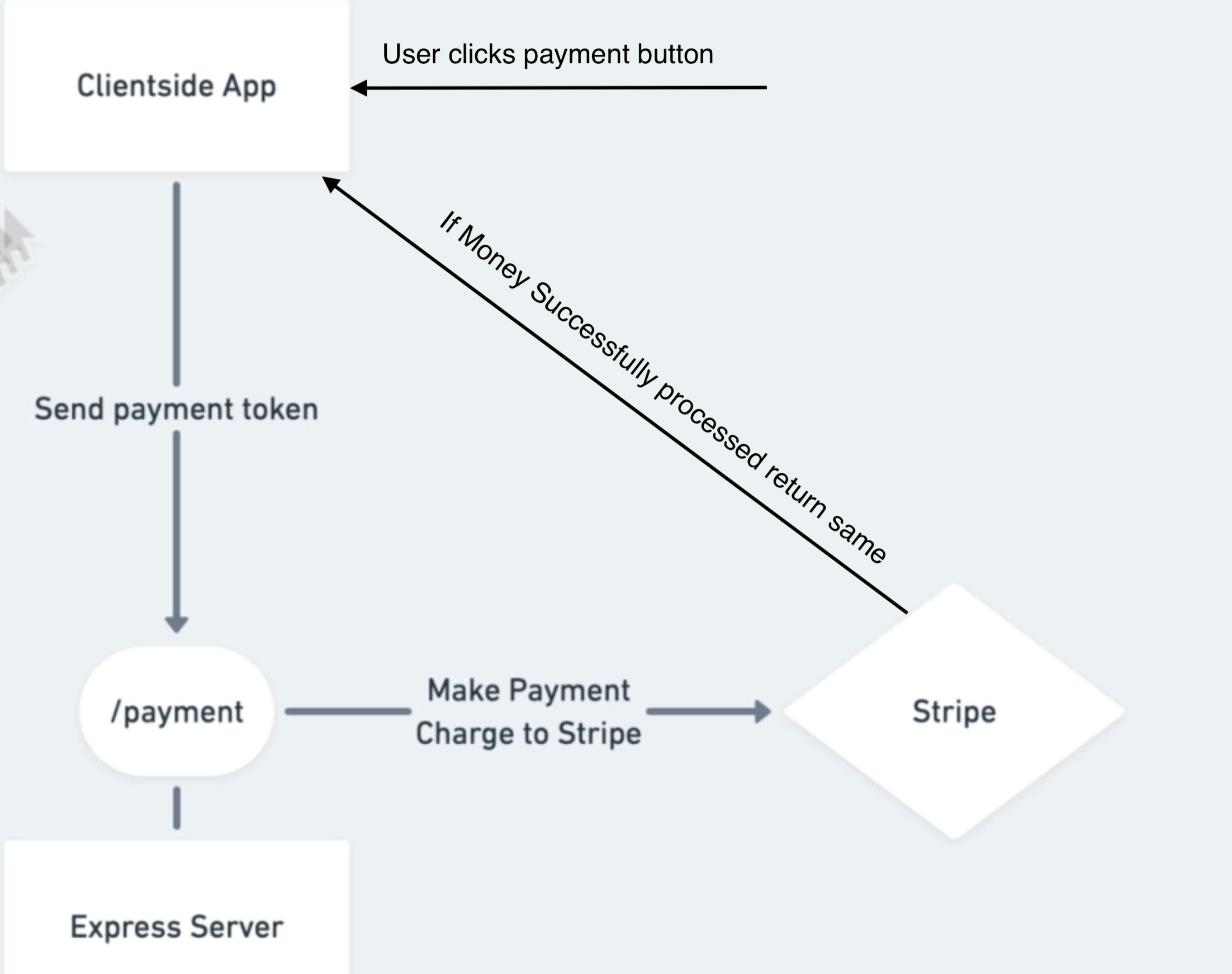
- Most React apps will have their files “bundled” using tools like Webpack etc. Bundling is the process of following imported files and merging them into a single file: a “bundle”. This bundle can then be included on a webpage to load an entire app at once. This ensures good speed after initial loading. However, if our app becomes large, bundle also increases leading increase in initial load time dramatically. Chunks are used to make bundles of our code.
- Solution is splitting the code which can create multiple bundles that can be dynamically loaded at runtime.
Code-splitting your app can help you “lazy-load” just the things that are currently needed by the user, which can dramatically improve the performance of your app. While you haven’t reduced the overall amount of code in your app, you’ve avoided loading code that the user may never need, and reduced the amount of code needed during the initial load.
- This is done by using dynamic imports which can be done using React.lazy. React.lazy takes a function that must call a dynamic import(). This must return a Promise which resolves to a module with a default export containing a React component.
- The lazy component should then be rendered inside a Suspense component, which allows us to show some fallback content (such as a loading indicator or a Component showing our page is Loading) while we’re waiting for the lazy component to load. Code
- A good place to start splitting is with routes. Most people on the web are used to page transitions taking some amount of time to load. You also tend to be re-rendering the entire page at once so your users are unlikely to be interacting with other elements on the page at the same time.(like we have done in APP and SHOPPAGE COMPONENTS).
ERROR BOUNDARY (IF SOME COMPONENT FAILED TO LOAD DUE NETWORK ERROR, GO TO A FALLBACK UI/PAGE INSTEAD OF UGLY STACKTRACE MSG )
- A class component becomes an error boundary if it defines either (or both) of the lifecycle methods static getDerivedStateFromError() or componentDidCatch(). Use static getDerivedStateFromError() to render a fallback UI after an error has been thrown. Use componentDidCatch() to log error information.
- Thus, we made a component called error-boundary which if error occurs renders the component described in it.
COMPONENT MEMOISATION USING React.memo() TO PREVENT CHILD COMPONENT FROM RE-RENDERING IF ITS STATE/PROPS DO NOT CHANGE IF PARENT RE-RENDERS
- We did this for cart-item which is a child of cart-dropdown component. Whenever a cart-item is added/removed from cart, cartItems[] changes and since it is a prop of cart-dropdown, it is re-rendered. Without memo, even cart-item which were already present in cart gets re-rendered as its parent was re-rendered(It renders cart-item for each item in cart-items).
- To prevent this, we memoize cart-item so that only if item prop of cart-item has changed, is it re-rendered. Code.
Note: IF Component is class Component extend PureComponent to memoise.
